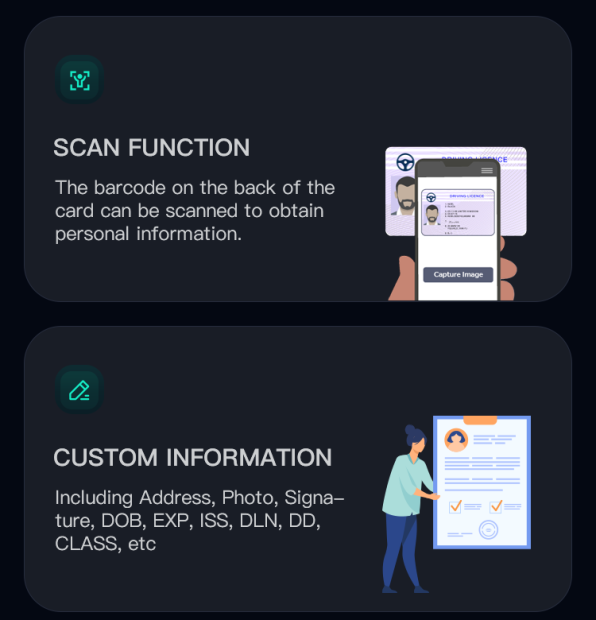Identity verification is a crucial aspect of modern society. From accessing government services to conducting financial transactions, having a reliable and secure way to prove one’s identity is essential. In recent years, the concept of Real ID has gained significant attention, and with the advent of new technologies, the future of ID verification is evolving. One such promising technology is quantum – dot – based ID verification.
Understanding Real ID
Real ID is a federal – level initiative in many countries aimed at enhancing the security of identification documents. It sets strict standards for driver’s licenses and identification cards, ensuring that they contain accurate and reliable information about the cardholder. The goal is to prevent fraud, identity theft, and enhance national security. For example, in the United States, a Real ID – compliant driver’s license has specific design features, such as a star in the upper – right corner, to indicate its compliance.
Real ID requirements typically include providing multiple forms of identification during the application process, such as a birth certificate, Social Security card, and proof of address. This multi – factor approach helps to verify the identity of the applicant more rigorously than traditional methods. The information on a Real ID is also encrypted and stored in a secure database, making it more difficult for unauthorized individuals to access or manipulate.

The Basics of Quantum – Dot – Based ID Verification
Quantum dots are nanoscale semiconductor particles that have unique optical and electronic properties. In the context of ID verification, these properties can be harnessed to create highly secure identification features. Quantum dots can emit light of specific wavelengths when excited, and this emission can be precisely controlled and measured.
One way quantum dots can be used in ID verification is by incorporating them into the design of identification documents. For instance, they can be printed as part of a security pattern on a driver’s license or an ID card. When illuminated with a specific light source, the quantum dots will emit a characteristic glow that can be detected by specialized readers. This glow is highly difficult to replicate, providing an additional layer of security compared to traditional security features like holograms or watermarks.
Another application is in biometric ID verification systems. Quantum dots can be used to label specific biomolecules, such as proteins or DNA, in a person’s body. When a biometric sample, like a fingerprint or a blood sample, is taken, the quantum – dot – labeled biomolecules can be detected and analyzed. This can provide a more accurate and secure way of verifying a person’s identity based on their unique biological characteristics.

The Convergence of Real ID and Quantum – Dot – Based ID Verification
The combination of Real ID and quantum – dot – based ID verification holds great potential for the future of identity security. By integrating quantum – dot technology into Real ID – compliant documents, the already high – level security of Real ID can be further enhanced.
For example, the quantum – dot – based security features on a Real ID could be used as an additional authentication factor during transactions. When a person presents their Real ID at a secure facility or during an online transaction, the quantum – dot emission can be verified in real – time, adding an extra layer of confidence in the identity of the cardholder. This could be especially useful in high – security environments, such as airports, government buildings, or financial institutions.
In addition, the use of quantum dots in biometric verification within the Real ID framework can improve the accuracy and reliability of identity authentication. If a Real ID system includes biometric data, such as fingerprints or facial recognition, the quantum – dot – enhanced biometric analysis can reduce the chances of false positives or false negatives, ensuring that only the rightful owner of the ID can access restricted services or areas.
Implementation Challenges and Solutions
Cost of Technology: One of the main challenges in implementing quantum – dot – based ID verification in conjunction with Real ID is the cost. Developing and producing quantum – dot – enabled identification documents and readers can be expensive. However, as the technology matures and economies of scale come into play, the cost is likely to decrease. Governments and private companies can also invest in research and development to find more cost – effective manufacturing processes for quantum dots and related components.
Compatibility with Existing Systems: Integrating quantum – dot – based verification into existing Real ID systems can be complex. There may be issues with compatibility between the new quantum – dot technology and the current infrastructure, such as card – reading devices and database management systems. To address this, standardization efforts should be made. Industry standards can be developed to ensure that quantum – dot – enabled ID cards and readers can work seamlessly with existing Real ID systems. This may involve cooperation between technology developers, government agencies, and industry stakeholders.
User Education: Many people may not be familiar with quantum – dot – based ID verification. There is a need for user education campaigns to inform the public about the benefits and security features of this new technology. Clear and concise communication can help build trust among the public, making them more comfortable with using quantum – dot – enabled Real ID documents. This can include brochures, online resources, and public awareness campaigns.
Data Privacy Concerns: With the use of biometric data in quantum – dot – enhanced ID verification, data privacy becomes a major concern. The collection, storage, and use of biometric information must be carefully regulated to protect the privacy rights of individuals. Strong data protection laws and regulations should be in place, and appropriate security measures, such as encryption, should be used to safeguard biometric data. Additionally, individuals should have control over their biometric information and be able to give or revoke consent for its use.
Security Vulnerabilities: No technology is completely immune to security threats. While quantum – dot – based ID verification offers enhanced security, there is still a need to constantly monitor and address potential security vulnerabilities. Regular security audits and penetration testing should be conducted to identify and fix any weaknesses in the system. The development of counter – measures against emerging threats, such as quantum – computing – based attacks, should also be a priority.
Common Problems and Solutions
- Problem: False Rejections in Quantum – Dot – Biometric Verification
Solution: False rejections can occur due to factors such as changes in the biometric sample quality (e.g., a dry or dirty fingerprint) or inaccuracies in the quantum – dot – based detection system. To address this, the system can be calibrated more frequently to account for variations in biometric samples. Additionally, machine – learning algorithms can be used to improve the accuracy of the detection system over time by analyzing a large number of biometric samples and their associated quantum – dot responses. - Problem: Difficulty in Quantum – Dot Printing on ID Documents
Solution: Printing quantum dots accurately on ID documents can be challenging due to their small size and the need for precise control. Specialized printing techniques, such as ink – jet printing with quantum – dot – containing inks, can be developed. Quality control measures during the printing process should also be implemented to ensure that the quantum – dot patterns are consistent and of high quality. This may involve using advanced imaging and measurement tools to monitor the printing process. - Problem: Interference with Quantum – Dot Emission
Solution: External factors, such as ambient light or electromagnetic interference, can potentially interfere with the emission of quantum dots during ID verification. To mitigate this, the quantum – dot – based ID verification systems can be designed with shielding and filtering mechanisms. For example, the ID card readers can be equipped with filters to block out unwanted light frequencies and sensors to detect and compensate for electromagnetic interference. - Problem: Lack of Skilled Personnel for Quantum – Dot – Based ID System Maintenance
Solution: As quantum – dot – based ID verification is a relatively new technology, there may be a shortage of skilled personnel to maintain and troubleshoot the systems. Training programs can be established to educate technicians and IT professionals about quantum – dot technology, its integration into ID systems, and maintenance procedures. Collaboration between educational institutions and industry can also help to ensure a steady supply of trained personnel in this field. - Problem: Slow Verification Speed in Quantum – Dot – Based Systems
Solution: In some cases, the process of detecting and analyzing quantum – dot emissions for ID verification may be time – consuming, leading to slow verification speeds. This can be improved by optimizing the design of the quantum – dot – based sensors and the associated data – processing algorithms. Faster computing hardware can also be used to speed up the analysis of the quantum – dot signals, ensuring that the ID verification process is efficient and does not cause long delays for users.
Fake ID Pricing
unit price: $109
| Order Quantity | Price Per Card |
|---|---|
| 2-3 | $89 |
| 4-9 | $69 |
| 10+ | $66 |



